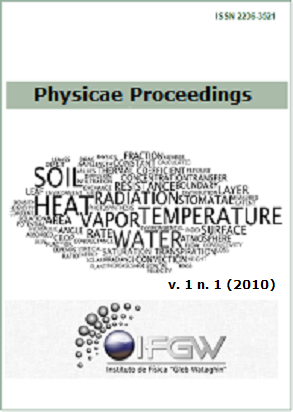Electron inertia effect on ?oating plasma potential
Palavras-chave:
Planar plasma sheath, Isothermal electronsResumo
The steady one-dimensional planar plasma sheath problem, originally considered by Tonks and Langmuir [1], is revisited. Two ?uid equations for cold ions and isothermal electrons, including terms for particle generation, have been numerically integrated together with Poisson’s equation. Three cases have been considered for the generation terms: constant, proportional to the electronic density or to the electronic density squared. Moreover, only cases of equal ion end electron ?uxes have been considered, since they correspond to walls at the plasma ?oating negative potential and they are consistent with a steady state Ampère Maxwell law. In all cases, the inclusion of electron inertia in the model allows to obtain the value of the plasma ?oating potential as resulting from an electron density discontinuity at the walls, where the electrons attain sound velocity and the electric potential is continuous. Even if this changes little the predicted values of ?oating potential reported in the literature (arising from the assumption of equating the ion ?ux to the one side randomic electron ?ux, corresponding to a Maxwell Boltzmann density distribution), such sonic shock build up is in accordance with a recently published study on the sheath properties [2]. Plots for densities, electric potential and particle ?uxes are presented, for hydrogen and mercury vapor, in terms of the density difference of the species at the middle of the con?guration.
Downloads
Referências
L. Tonks and I. Langmuir, Phys. Rev. 34, 876 (1929).
B. Alterkop, J. Appl. Phys. 95, 1650 (2004).


